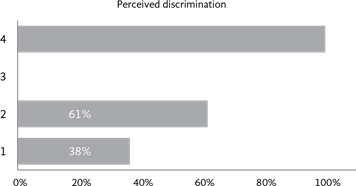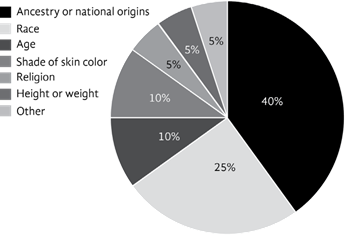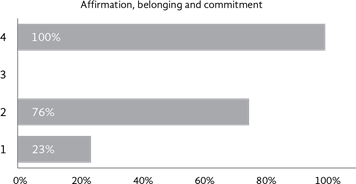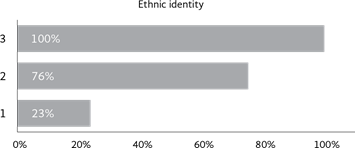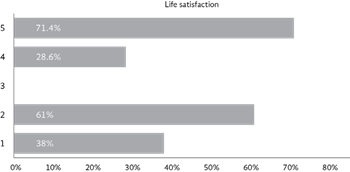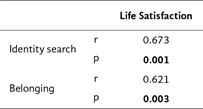Introduction
Ethnic identity is rooted in an individual’s comprehension of their ancestral and cultural ties, es- pecially the formative traditions that represent their ethnic group (Newman & Newman, 2020) that influences a person's sense of belonging, judgment of membership, and personal identifi- cation (Phinney & Ong, 2007). Ethnic identity has intrapersonal and interpersonal components as indicated by the model of in-group identification which encompasses the following concepts: self-definition (similarities the individual identifies to have with the group) and self-investment (positive regard and solidarity for the group bond) (Leach et al., 2008; Milanov et al., 2014).
Discrimination refers to unfair treatment individuals experience based on attributes such as gen- der, age, ethnicity, sexual orientation, or disability (Straiton et al., 2019). Perceived discrimina- tion refers to an individual’s own interpretation of being targeted or discriminated against. This is a prevalent issue in many societies, and research has shed light on its existence and impact on different populations, which will be explored further below.
Pengpid and Peltzer (2021) studied the relationship between perceived discrimination and health outcomes in a sample of middle-aged and older adults. The results revealed a significant relations- hip between perceived discrimination and negative health outcomes. Age, financial status, and caste are the three most common reasons attributed to perceived discrimination. Age and finan- cial discrimination were revealed to have a positive relation to lower life satisfaction, and depres- sive symptoms. These results suggest that higher frequency in racial and financial discrimination contribute to a higher frequency of negative mental health outcomes.
Life satisfaction is understood as an individual’s favorable subjective assessment in their life (Hall, 2014; APA, 2022). Tran & Sangalang (2016) studied relationship between racial or ethnic discri- mination, perceived influence of Asian Americans’ identity, in educational and occupational set- tings, and overall state of well-being. Findings revealed that Asian Indian and Vietnamese Ameri- cans experienced greater life satisfaction when they perceive the benefits linked to their ethnic identity. However, it’s essential to acknowledge that positive stereotypes, despite their seemingly favorable nature, still function as stereotypes. This is evident from the Japanese Americans’ lower levels of life satisfaction which were observed among individuals who placed greater belief in the practical advantages associated with these stereotypes.
Various studies have examined the relationship between perceived discrimination, ethnic iden- tity, and life satisfaction in the Maori community (Stronge et al., 2016; Houkamau et al., 2021; Manuela, 2021). Stronge et al. (2016) found that perceived discrimination shares a positive re- lationship with ethnic identity and a negative one with life satisfaction. Houkamau et al. (2021) conducted a seven-year study on the effects of ethnic identity centrality and in-group warmth on self-esteem, personal well-being, and life satisfaction. In other words, the aim was to study individuals’ attachment to their own ethnic identity as well as the level of connection accordin- gly. Their findings revealed that a decline in-group warmth corresponded to a decrease in eth- nic identity centrality. Essentially, individuals tend to value their ethnic identity less when they feel less connected to their ethnic group. Additionally, Manuela (2021) suggested that a higher ethnic identity acts as a protective factor against the negative impact of discrimination on life satisfaction.
According to a study on undocumented immigrants, having a strong sense of ethnic identity offe- red psychological protection from reportedly high levels of discrimination (Cobb et al., 2019). Furthermore, it was observed that a strong ethnic/racial played a role in diminishing the adverse effects of discrimination, thereby enhancing life satisfaction. The sense of belonging fostered by ethnic identity acted as a shield against the repercussions of discrimination. Empowerment is encouraged to potentially be a powerful tool in counseling undocumented Hispanic immigrants in order to mitigate the harmful impacts of discrimination.
Yap et al. (2011) found that racial identity shares a positive relation with life satisfaction in a study of 161 African American women and men. Their findings revealed that racial identity plays a significant role in life satisfaction, personal well-being, and self-esteem. A connection between racial centrality and private esteem with a sense of belonging was found in both gender groups, but women experienced higher levels of satisfaction when they felt a strong sense of belonging- ness. An important limitation is that due to the small sample size and the fact it’s based solely in Michigan; it would only be representative of African Americans based in Michigan.
In the present study, it is expected that there is a relationship between perceived discrimination and ethnic identity and life satisfaction among young, middle aged and older adults in Porongo. The following hypothesis was formulated: Young adults (18-41) scored lower on life satisfaction, perceived discrimination and ethnic identity compared to older adults (42 and above).
The main objective of this study is to compare the levels of perceived discrimination, cultural identity and life satisfaction among adults between the ages 18 and older in Porongo. This study also aims to analyze the relation between the mentioned variables.
Methodology
Research design
The current study is non-experimental and cross-sectional, considering no variables were mo- dified. Data from the Porongo population was gathered at a single point in time, analyzed, and evaluated based on the measurement of outcomes involving demographic variables (age, gender, education and ethnicity) in relation to ethnic identity, perceived discrimination, and life satisfac- tion. This is why the study is referred to as cross-sectional (Setia, 2016). This study follows an ex post facto design as it compares scores in perceived discrimination, ethnic identity and life satisfaction between young adults and older adults without the manipulation of any independent variables. It focuses on describing the differences between two pre-existing groups based on participants’ age.
Participants
The sample is made up of a total of 20 participants who currently reside in Porongo, a town in Bolivia's Santa Cruz region, 80% of the participants were female and 20% male. The mean age is 34, with the minimum being 18 and the maximum 67 (ST=15.27). The sample used was non-pa- rametric because, despite its lack of normal distribution, it represents a particular segment of the Porongo population. The participants were 65% young adults (ages 18 to 41) and 35% older adults (ages 42 to 67).
Furthermore, 70% of the participants completed a secondary education, 20% completed univer- sity and the remaining 10% completed primary education. In the subject of ethnicity, 60% of the participants identified as being Mestizo, 15% identified as being Aymara, 10% identified as being Cruceño, 5% identified as being Chiriguano, 5% as Castellano, and 5% as Guaraní.
Instruments
Ethnic identity will be assessed by the Spanish version (Smith-Castro, 2011) of the revised ver- sion of the Multigroup Ethnic Identity Measure (Phinney, 1992). This version measures two di- mensions of ethnic identity: 1) ethnic identity search 2) affirmation, belonging and commitment. Identity search encompasses the developmental and cognitive component while affirmation, be- longing and commitment constitutes the affective component. For the purpose of identification and ethnic categorization, the last three items asked the participant’s ethnicity, the father’s eth- nicity and the mother’s ethnicity. The participants must select a response based on the 4-point Likert scale: strongly agree, agree, disagree, and strongly disagree. The scoring is to use the means of the 5 identity search items and 7 affirmation items separately or use the mean of the 12 items. Regarding the validity and replicability of the scale, Smith-Castro (2011) conducted a study within the Costa Rican context among adolescents categorized in three ethnic groups: Afro Costa Rican, white/mestizo, and mulatos. The Cronbach 's alpha of the items of the overall scale include: .86 for Afro costa-ricans, .78 for mestizos, and .87 for mulatos. Therefore, these results would indicate that the scale has proficient internal consistency among these samples, taking in consideration that the ideal scores are between .80 and .90 (Oviedo & Campo-Arias, 2005).
Perceived discrimination is assessed by the short version of the Daily Discrimination scale of alpha = .77 (Williams et al., 1997). The Spanish version was developed by Campos-Arias et al. (2015) and used for this study. This scale was designed to measure the three dimensions of discrimi- nation: unjust treatment, stereotypes, and generalized discrimination. The participants respond based on the following 6-point Likert scale in “Almost every day” (1), “At least once a week” (2), “A few times a month” (3), “A few times a year” (4), “Less than once a year” (5) and Never” (6). There are five items, which asks the participants to respond based on their experiences and a follow up question with 10 options to select in response to the question “What do you think is the main reason for these experiences?”. The 10 optional responses include: ancestry or national origins, gender, race, religion, height, weight, aspect of physical appearance, sexual orientation, education or income level. Campo-Arias et al. (2015) reported a Cronbach's alpha of 0.83 among medical students at a university in Bucaramanga, Colombia. This result indicates excellent inter- nal consistency among college students, as scores between .80 and .90 are considered desirable (Oviedo & Campo-Arias, 2005). This instrument has been proven valuable for assessing percei- ved discrimination across numerous countries, encompassing both general and specific popula- tions (Bastos & Harnois, 2020).
Life satisfaction is assessed by the Spanish version Satisfaction of Life Scale (Diener et al., 1985; Atienza et al., 2000; Pons et al., 2002) which measures the cognitive component of the well-be- ing construct (Pavot & Denier, 1993). In other words, this scale was developed by Diener et al. (1985) to evaluate a person's conscious judgment of their life based on their own criteria. On a seven-point scale that goes from 7 for strongly agree to 1 for strongly disagree, participants indicate their level of agreement. The scale contains five items, one of which include: “In most ways of my life is close to my ideal. A study conducted by Blazquez et al. (2015) revealed that the Cronchback’s alpha in the Mexican population is .83. Since the scores between .80 and 90 are considered proficient, this score confirms the adequate internal consistency of this scale (Oviedo & Campo-Arias, 2005).
Results
In this section The Everyday Discrimination Scale was used to describe different levels of discri- mination, the Multigroup Ethnic Identity Scale's was used to assess ingroup identification while describing the dimensions belonging, affirmation/commitment. Life Satisfaction scale was used to describe different levels of life satisfaction. Below is a demonstration of the results.
As observed in Figure 1, more than half of the young adults presented high levels of discrimina- tion. However, all the older adults experienced high levels of discrimination.
Figure 2 indicated that an individual’s ancestry or national origins are the most frequent factors leading to perceived discrimination accompanied by race and age and skin color. In other words, majority of the participants attributed the discrimination to their ancestry.
Figure 3 revealed that 23% of young adults experience low levels of affirmation and belonging in respect to their ethnic identity and 76% experience high levels of affirmation and belonging. Furthermore, all older adults experience high levels of affirmation and belonging regarding their cultural identity.
Figure 4 demonstrated that 23% of young adults experience low levels of ethnic identity and 76% experience high levels of cultural identity. Furthermore, all older adults experience high levels of cultural identity.
Figure 5 reveals that 38.5% of young adults experience low levels of life satisfaction and 61.5% experience high levels of life satisfaction. This indicates that the majority of young adults have high life satisfaction. In addition, 28.6% of older adults experience low life satisfaction and 71.4% experience high life satisfaction. This indicates that the majority of older adults experience high levels of life satisfaction.
Correlations
Spearman’s correlation was utilized to observe the relationships between the variables of percei- ved discrimination, ethnic identity and life satisfaction. Spearman’s rho was employed due to the fact the variables are ordinal and the use of a nonparametric sample.
Table 1. Correlations between perceived discrimination, ethnic identity and life satisfaction
There is a moderate and significant relationship between perceived discrimination and life satis- faction (r = 0.466, p = .038). While this would indicate that the more discrimination perceived, the higher the life satisfaction, the relationship is weak. This could suggest that the rise of life satisfaction scores with increasing discrimination may possibly be attributable to ethnic identity scores, indicating a potential protective function of ethnic identity in response to perceived dis- crimination which will be further explored in the discussion.
Table 2. Correlations of ethnic identity search and belonging in relation to perceived life satisfaction
Given the identified correlation between MEIM and life satisfaction, the relationship is further explored through the ethnic identity dimensions: identity search and belonging. As a result, there is a moderate and significant relationship between ethnic identity search and life satisfaction (r = .673, p < .001). Furthermore, there is also a moderate and significant relationship between belon- ging and life satisfaction (r = .621, p = 0.003). This means that the greater the sense of belonging the participants presented, the better their life satisfaction was. Likewise, the greater the search for ethnic identity, the greater the satisfaction.
Comparisons
A Mann U Whitney test was used to evaluate the differences between men and women in per- ceived discrimination, ethnic identity and life satisfaction. The following table demonstrates the comparison between two independent groups of men and women regarding perceived discrimi- nation, ethnic identity and life satisfaction.
Table 3. Differences between female and male participants regarding perceived discrimination, ethnic iden- tity and life satisfaction.
The test revealed insignificant differences in perceived discrimination between female and male participants (U = 30.5, Mr (female) = 24 .00, Mr (male) = 26.50, p = .887). In addition, there are also insignificant differences in ethnic identity between female and male participants (U = 29.5, Mr (female) =32.5, Mr (male) = 32.0, p = .812). Ultimately, there are insignificant differences in life satisfaction between female and male participants (U = 23, Mr (female) =17.5, Mr (male) = 17.5, p = .887).
Table 4. Comparison between two items of the EDS and 25% of the upper and lower groups of the MEIM
The Mann-Whitney U Test revealed significant differences between the item “You are treated with less courtesy than other people are” and the 25% of upper and lower groups of the Multi- group Ethnic Identity Scale (U = 5.5, Mr (25% lower group) = 4, Mr (25% higher group) = 5.5, p = .036). Moreover, the test also revealed significant differences between the item “People act as if they are afraid of you” and the 25% of upper and lower groups of the Multigroup Ethnic Identity Scale (U = 6, Mr (25% lower group) = 3.5, Mr (25% higher group) = 6, p = .041).
Table 5. Comparison of age groups and the total of MEIM
A Kruskal-Wallis test was conducted to evaluate the differences between a new classification of age groups (young, middle aged, and older adults) and the total of the Multigroup Ethnic Identity Scale. Therefore, it was shown that there are no significant differences between young, midd- le-aged and older adults in terms of the MEI total H(2) = 5.793; p = 0.055. However, this does not suggest that further investigation is not necessary given that a greater sample size improves the reliability of the findings (Giovanni Di Leo & Sardanelli, 2020).
Discussion
The current study aimed at describing levels of perceived discrimination, ethnic identity and life satisfaction among younger and older adults in Porongo. The main objective of the research was to compare the scores of the previously mentioned variables between young adults and older adults. Older adults were found to experience higher levels of all variables than young adults. For instance, it was revealed that 71% of older adults experience high levels of life satisfaction in ad- dition to high levels of high discrimination and cultural identity. This is contrary to the findings in Marquet et al. (2018) in which age discrimination experienced by older adults is associated with negative self-perceptions, subsequently affecting their well-being. However, the findings were consistent with the results in Gomez Berrocal et al. (2019), which revealed that participants with higher scores for ethnic identification also showed greater levels of life satisfaction. The study also encouraged future research to bridge the gap regarding whether this correlation suggests the use of a coping strategy to address discriminatory experiences by seeking acceptance from the in-group (Branscrombe et al., 1999 as cited in Gomez-Berrocal et al., 2019).
In this study a relation between perceived discrimination and life satisfaction was found, these re- sults are similar in Stronge et al. (2016). It was further clarified in Stronge et al. (2016), however, that perceived discrimination was directly linked to low life satisfaction and indirectly linked to high life satisfaction. In contrast to Stronge et al. (2016) who found a high correlation between reported discrimination and increasing levels of ethnic identification, it was shown in the current study that there is no association between perceived discrimination and cultural identity. Con- trary to Mossakowski's (2018) findings, there is an insignificant correlation between perceived discrimination and ethnic identity in this study. The affirmation factor of ethnic identity and life satisfaction were found to be significantly correlated, supporting the findings in Houkamau et al. (2021) which stated that in-group warmth had a beneficial effect on life satisfaction. Similar fin- dings were found by Yap et al. (2011) in a sample of African American women and men, showing a strong and positive link between cultural identification and life happiness. The indication that higher degrees of belonging are associated with higher levels of life satisfaction was another com- monality.
It is important to mention that although no significant differences were found between these three variables and the groups, the descriptive results evidently demonstrate that these variables are scored higher in older adults than in younger adults. These results are similar to those found in the study conducted in Gomez Berrocal et al. (2019). Gomez, using a sample of 229 participants (all of whom are Spanish Gypsies) concluded that there are higher levels of life satisfaction in participants with higher levels of ethnic identity. It was further suggested that ingroup identifi- cation is connected to the concept of well-being in positive relationships with other members of the cultural group. However, further testing is required to determine if positive identification with the ingroup is used as a “tactic” that could fulfill the need to be accepted and compensate for the discriminatory experiences.
Regarding the listed reasons of perceived discrimination, ancestry or national origins remains the most frequent, accompanied by age, race and skin color; all of which could potentially be attributed to the inequality that remains prevalent in Latin America as observed in Painter et al. (2019) which studied the role skin tone and racial ethnicity has in wealth inequality across 13 Latin-American countries. The influence of race and ethnicity on vehicle ownership in Venezuela was evident as three different ethnic groups (Indigenous, Black and Mestiza) experience lower rates of vehicle ownership than their white, mixed-race and Morena counterparts. The study sug- gested that skin color is possibly a more effective indicator of inequality in Latin America as dark skin tones were associated with reduced vehicle ownership in countries such as Antigua, Barbuda, St. Kitts, and Nevis.
One of the possible reasons for the lack of significant differences was the small sample size, which is known for lowering the accuracy of some results (Andrade, 2020). Lastly, as an interesting piece of information, no significant differences were discovered between men and women when the variables were compared. The current findings on insignificant differences between men and women are at odds with those of Yap et al. (2011), who discovered that women had greater le- vels of life satisfaction than males do.
Conclusion
The results provided information concerning the differences between age groups despite the fact that no significant differences were observed. For instance, the study currently validated the hypotheses that older adults experience higher levels of perceived discrimination, ethnic iden- tity and life satisfaction. When the sample is further separated into younger, middle-aged, and older individuals, the only significant differences between the age categories are observed in the differences between 25% of upper and lower groups in the MEIM total. There are no significant differences between women and men in any of the variables. However, it is intriguing to note the relationship found between the variables. Although at first, the positive relation between discri- mination and life satisfaction could be perceived as unconventional but it’s worth considering that ethnic identity may have an influence in this result as previously mentioned.
The exceedingly small sample size of the current study is a major limitation that may have impac- ted the accuracy of the findings in terms of how representative the sample is of the population (Andrade, 2020). The inability to divide the sample into different ethnic groups to examine dis- crimination, cultural identification, and life satisfaction levels may have been caused by the small sample size. Nonetheless, this study contributes to the already limited research regarding the Po- rongo population and provides a first step towards exploring this culture and the motives behind the variables used. Further research is encouraged to explore the causal connection between cul- tural identity, and life satisfaction in the face of perceived discrimination with a larger sample size.













